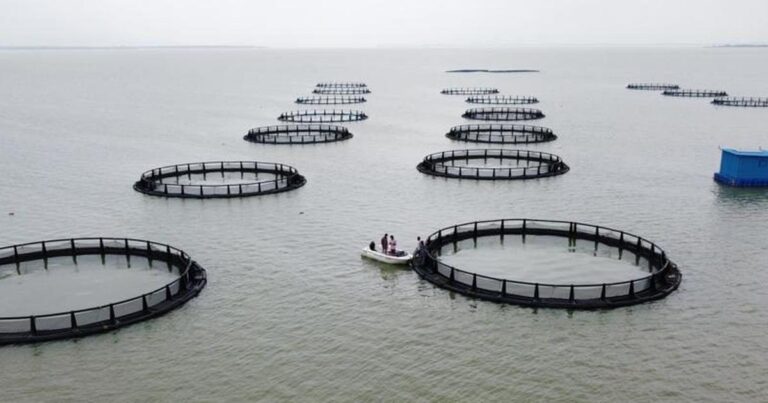In this day and age, Cage Culture Fish Farming has emerged as a prominent and sustainable method to meet the escalating global demand for seafood in the dynamic field of cage aquaculture among others. With the world’s population on a steady rise, the pressure to enhance food production has led to innovations in the cage aquaculture sector. Cage culture fish farming, also known as sea cage farming, offers a promising solution by optimizing space and resources while minimising environmental impact.
Understanding Cage Culture Fish Farming
Cage culture fish farming involves raising fish in floating cages within open water bodies, such as lakes, rivers, or coastal areas. This method provides a controlled environment for fish to grow and thrive, offering a balance between economic efficiency and environmental sustainability. The cages act as a confined space where fish can be fed, monitored, and harvested with precision.
In India, other brackish water sources are being increasingly utilized for cage aquaculture and several government schemes and policies are helping individuals and groups set up these farms in an effective and efficient manner.
Advantages of Cage Aquaculture
Optimal Space Utilization: One of the key advantages of cage culture fish farming is its ability to maximize space utilisation. Unlike traditional aquaculture ponds, cage systems allow farmers to utilize open water bodies efficiently. This results in higher fish stocking densities, leading to increased production per unit area.
Reduced Environmental Impact: Cage culture minimizes the environmental footprint associated with traditional fish farming. By confining fish to designated cages, the risk of nutrient runoff and habitat disruption is significantly reduced. This environmentally conscious approach aligns with the growing demand for sustainable and responsible aquaculture practices.
Improved Water Quality Management: Proper water quality management is crucial for the success of cage aquaculture. Regular monitoring and maintenance of water parameters, such as dissolved oxygen levels and temperature, contribute to a healthy and thriving fish population. This precision in water quality management enhances overall farm productivity. When it comes to sea cage farming, these management practices become that much more essential as there are several additional factors that might end up modifying the characteristics of the water on the farm.
Key Strategies for Maximizing Efficiency in Cage Culture Fish Farming Operations
Site Selection and Assessment: The success of a cage culture fish farming operation begins with meticulous site selection. Factors such as water quality, depth, currents, and accessibility play a vital role in determining the suitability of a location. Conducting a comprehensive site assessment ensures that the chosen area aligns with the specific requirements of the fish species being cultivated. Properly laid-out policies are essential for inland and sea cage farming for fisheries.
Investment in Quality Cages and Infrastructure: The foundation of a successful cage culture operation lies in the quality of cages and infrastructure. Investing in durable and well-designed cages not only ensures the safety and security of the fish but also contributes to the longevity of the farming operation. Regular maintenance and periodic upgrades are essential to address wear and tear caused by environmental factors.
Species Selection and Stocking Density Optimization: Choosing the right fish species for cage culture is a critical decision that influences the overall success of the operation. Factors such as market demand, environmental compatibility, and growth rates should be considered when selecting fish species. Additionally, optimising stocking densities based on the species’ characteristics and environmental conditions is essential for achieving maximum production.
Nutrition Management and Feed Efficiency: Proper nutrition is fundamental to the health and growth of fish in cage culture systems. Implementing a well-balanced and nutritionally complete feed regimen is crucial. Monitoring feed conversion ratios and adjusting feeding practices based on fish behaviour and growth rates contribute to improved feed efficiency, minimizing waste and maximizing cost-effectiveness.
Water Quality Monitoring and Management: Continuous monitoring of water quality parameters is essential for maintaining a healthy aquatic environment. Regular testing for factors such as dissolved oxygen, pH, and ammonia levels allows farmers to identify and address potential issues promptly. Implementing water circulation systems and aeration devices further enhances water quality, supporting optimal fish growth.
The Future of Cage Culture Fish Farming
As global demand for seafood continues to rise, the role of cage culture fish farming in meeting this demand is becoming increasingly significant. The versatility and efficiency of this method make it a viable option for both coastal and inland areas. With advancements in technology and a growing understanding of sustainable aquaculture practices, cage culture is poised to play a pivotal role in shaping the future of the cage aquaculture industry.
To sum it up:
Maximizing efficiency in cage culture fish farming operations requires a holistic approach that encompasses careful site selection, quality infrastructure, species-specific management practices, and a commitment to environmental sustainability. By implementing these strategies, fish farmers can unlock the full potential of cage culture, contributing to a more resilient and sustainable aquaculture industry. As we navigate the challenges of feeding a growing global population, the innovation and precision of cage culture fish farming stand out as a beacon of hope for a more sustainable and food-secure future.


Comments are closed.